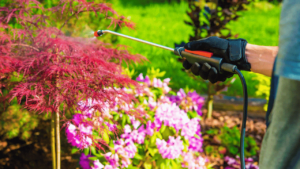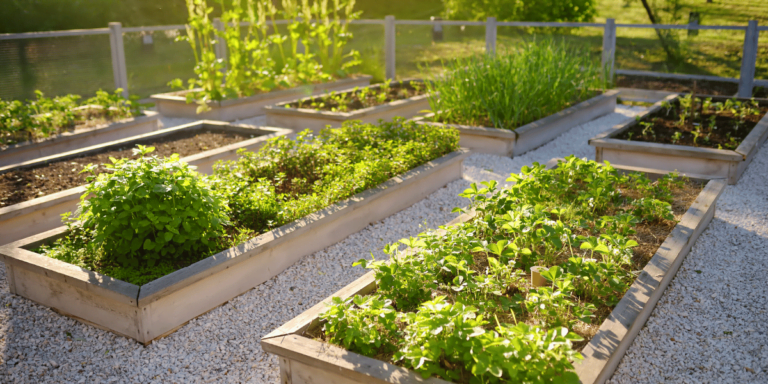Garden pest prevention is crucial for maintaining a healthy and thriving garden. By taking proactive measures and following organic gardening practices, you can minimize the risk of pest infestations and promote a sustainable environment. In this section, we will provide you with valuable tips and techniques to prevent garden pests using natural and environmentally friendly methods.
Key Takeaways:
- Garden pest prevention is essential for a healthy and thriving garden.
- Proactive measures and organic gardening practices can minimize the risk of pest infestations.
- Choose natural and environmentally friendly methods for pest control.
- Integrated Pest Management (IPM) is a comprehensive approach that helps garden pests prevention.
- Regular monitoring and early action are crucial in preventing and controlling pests.
Understanding the Importance of Organic Pest Control
When it comes to pest control in your garden, relying on organic pesticides and homemade insect sprays may seem like a safe option. However, these methods can have unintended consequences that harm beneficial insects and disrupt the natural balance of the soil. Instead of resorting to chemical solutions, it’s important to understand the importance of organic pest control and focus on creating a healthy garden ecosystem that can naturally fend off pests.
Organic pesticides, derived from natural sources, offer a viable alternative to synthetic chemical pesticides. They are formulated to target specific pests while minimizing harm to beneficial insects and other organisms. By using organic pesticides, you can protect your garden from pests without compromising the health of the environment. Additionally, opting for natural solutions promotes sustainable farming practices and contributes to a healthier ecosystem.
To effectively prevent pest infestations, it’s crucial to prioritize soil health. A healthy soil ecosystem is a natural defense against pests. The soil contains a diverse community of beneficial microbes and organisms that help maintain a balanced environment. When the soil is rich in nutrients and organic matter, plants are better equipped to resist pests and diseases.
One way to promote soil health is by incorporating organic matter through composting. Compost improves the soil’s structure, water-holding capacity, and nutrient content, creating an optimal growing environment for your plants. Additionally, using natural fertilizers, such as compost tea or seaweed extract, can provide essential nutrients to the soil and enhance its ability to support healthy plant growth.
Attracting beneficial insects is another effective strategy for organic pest control. Beneficial insects, such as ladybugs, lacewings, and hoverflies, prey on garden pests and act as natural pest control agents. To attract these beneficial insects to your garden, you can plant flowers that provide nectar and pollen or create habitats such as bee houses or bug hotels.
Benefits of Organic Pest Control
| Benefits | Explanation |
|---|---|
| Preserves beneficial insects | Organic pest control methods do not harm beneficial insects, ensuring a balanced ecosystem. |
| Promotes soil health | By avoiding synthetic pesticides, organic pest control methods contribute to soil health and the overall sustainability of your garden. |
| Reduces chemical exposure | Organic pest control methods minimize the use of harmful chemicals, reducing exposure to toxins for you and your family. |
| Improves long-term garden health | By focusing on natural solutions, organic pest control helps create a resilient and healthy garden, making it less susceptible to pest infestations. |
In summary, understanding the importance of organic pest control is crucial for maintaining a healthy and sustainable garden. By utilizing organic pesticides, promoting soil health, and attracting beneficial insects, you can effectively prevent pest infestations without relying on harmful chemicals. Embracing organic gardening practices not only protects your plants but also contributes to the overall well-being of the environment.
Encouraging Healthy Soil for Garden Pest Prevention
Healthy soil is the foundation for a pest-free garden. By enriching your soil with natural fertilizers like fish and seaweed fertilizer, you can activate beneficial soil microbes that help feed plants and keep them healthy. These microbes also contribute to disease resistance, making your plants less susceptible to pest attacks. Implementing organic soil improvement techniques is an essential step in preventing garden pests.
One effective way to encourage healthy soil is by incorporating natural fertilizers into your gardening routine. Fish and seaweed fertilizers provide essential nutrients that nourish your plants and promote their overall health. These fertilizers contain a wide range of essential elements like nitrogen, phosphorus, and potassium, which are crucial for plant growth and development.
Moreover, fish and seaweed fertilizers support the growth and activity of beneficial soil microbes. These microorganisms play a vital role in breaking down organic matter, converting it into nutrients that are readily available for plants. They also help create a favorable environment for plant roots, improving their nutrient uptake and overall health.
Incorporating Fish and Seaweed Fertilizers into Your Garden
To benefit from fish and seaweed fertilizers, follow these simple steps:
- Mix the fish and seaweed fertilizers according to the manufacturer’s instructions.
- Apply the fertilizer mixture to the soil around the base of your plants.
- Water the area well to help the fertilizer penetrate the soil and reach the roots.
- Repeat the application at regular intervals throughout the growing season.
By incorporating fish and seaweed fertilizers into your garden, you nourish your plants, support beneficial soil microbes, and enhance their disease resistance. Healthy soil acts as a natural defense system against pests, creating an inhospitable environment for them to thrive.
| Fertilizer | Nutrient Content | Benefits |
|---|---|---|
| Fish Fertilizer | Rich in nitrogen, phosphorus, potassium, and micronutrients | Provides essential nutrients for plant growth Supports beneficial soil microbes Enhances disease resistance |
| Seaweed Fertilizer | Contains trace minerals, plant hormones, and growth stimulants | Improves nutrient uptake Enhances plant vigor and resilience Stimulates root development |
Choosing Resistant Plant Varieties With Garden Pests Prevention

One effective way to prevent garden pests is by selecting plant varieties that are naturally resistant to common pests. Seed catalogs often list varieties known for their pest resistance. For example, tromboncino squash is known to be more resistant to pests compared to other summer squash varieties. By choosing resistant plant varieties, you can reduce the risk of pest infestations in your garden.
When browsing through seed catalogs, look for specific indications of resistance to pests. These varieties have been bred or selected for their ability to withstand pest attacks and have built-in mechanisms to deter or repel pests. By planting such varieties, you can minimize the use of chemical pesticides while still enjoying a bountiful harvest.
Here are some examples of resistant plant varieties:
- Cabbage variety: Gloria – Resistant to cabbage worms and aphids
- Tomato variety: Legend – Resistant to diseases like late blight and tomato spotted wilt virus
- Bean variety: Provider – Resistant to common bean diseases and pests
- Carrot variety: Scarlet Nantes – Resistant to carrot fly
By choosing these resistant varieties, you can grow healthy and pest-resistant plants, ensuring a thriving garden without the need for extensive pest control measures. It’s important to note that even resistant plants may still attract some pests, but they are generally more tolerant and less susceptible to severe damage.
Image: A selection of resistant plant varieties showcased in a seed catalog.
Proper Planting and Companion Planting Techniques with Garden Pests Prevention

Proper plant placement plays a crucial role in preventing garden pests and promoting a healthy garden ecosystem. By planting crops in the right place, considering their sunlight and water requirements, you can reduce stress on plants and make them less susceptible to pest infestations. Additionally, incorporating companion planting techniques and interplanting different crops can create a natural pest control system.
When planning the layout of your garden, take into account the specific needs of each plant. Some plants thrive in full sun, while others prefer partial shade. By providing the ideal growing conditions for each crop, you can strengthen their natural defenses and discourage pests.
Table: Examples of Plant Placement to Prevent Pest Infestations
| Plant | Placement |
|---|---|
| Tomatoes | Full sun with adequate spacing between plants for good air circulation |
| Lettuce | Partial shade to prevent bolting due to excessive heat |
| Zucchini | Well-drained soil to avoid root rot and allow water to flow away, discouraging fungus and pests |
| Herbs like basil, cilantro, and mint | Planted around the garden to deter pests with their strong scent |
Companion planting, the strategic placement of different plant species to support each other’s growth, can also contribute to pest prevention. For example, interplanting marigolds with vegetables can repel harmful insects, as marigolds emit a scent that pests find unappealing. Similarly, planting herbs like rosemary and thyme alongside susceptible plants can confuse pests and deter them from invading your garden.
Moreover, attracting beneficial insects to your garden provides natural pest control. Beneficial insects such as ladybugs, lacewings, and hoverflies feed on harmful pests, helping to maintain a balanced ecosystem. Planting flowers such as daisies, sunflowers, and lavender can attract these beneficial insects, providing them with nectar and shelter throughout the growing season.
By implementing proper plant placement techniques and utilizing companion planting strategies, you can create a thriving garden that naturally wards off pests while supporting the growth of your favorite crops.
Pest Repellents and Mechanical Controls
When it comes to preventing garden pests, utilizing pest repellents and mechanical controls can provide additional layers of defense. These methods work alongside other preventive measures to keep your garden free from unwanted invaders. Let’s explore some effective techniques:
1. Strong-scented Herbs
Planting strong-scented herbs like basil, mint, and rosemary among or near your vegetables can deter pests. The powerful aromas emitted by these herbs confuse and repel pests, making them less likely to attack your plants. In addition to their pest-repellent properties, these herbs also add a delightful fragrance to your garden. So, consider incorporating them into your pest control strategy.
2. Floating Row Covers
Floating row covers are a fantastic physical barrier that can create an impenetrable shield against pests while allowing water and light to reach your plants. These lightweight covers are made from translucent material and can be placed directly over your garden bed. The covers not only protect your plants from pests but also provide a microclimate that promotes healthy growth. Make sure to secure the edges of the row covers to prevent pests from finding their way in.
3. Copper Strips
If slugs and snails are causing havoc in your garden, copper strips can be a game-changer. These simple yet effective pest deterrents work by creating an electric charge when in contact with the slimy pests, deterring them from crossing the barrier. Place copper strips around the borders of your garden beds or containers to keep slugs and snails at bay. Remember to regularly clean the copper strips to maintain their effectiveness.
4. Manual Pest Control
While pest repellents are helpful, sometimes nothing beats good old manual pest control. Taking the time to manually pick off pests, such as caterpillars or beetles, early in the morning when they are less active can significantly reduce their numbers. Regularly inspect your plants for signs of pest infestation and remove any visible pests by hand. It requires a bit of patience and diligence, but the results are worth it.
By implementing these pest repellents and mechanical controls, you can strengthen the defenses of your garden against unwanted intruders. Whether it’s using the natural power of strong-scented herbs, the physical barrier of floating row covers, the slug-deterring properties of copper strips, or good old manual pest control, these methods offer effective and eco-friendly ways to keep your garden thriving and pest-free.
Integrated Pest Management Techniques
Integrated Pest Management (IPM) is a comprehensive approach to preventing garden pests. By combining various strategies and techniques, you can effectively control pests while minimizing harm to the environment. Let’s explore some key IPM techniques:
1. Beneficial Insects
One of the most effective IPM strategies is the release of beneficial insects, such as ladybugs and lacewings. These natural predators feed on common garden pests, including aphids, caterpillars, and mites. By introducing these beneficial insects into your garden, you can significantly reduce pest populations without relying on harmful chemicals.
2. Homemade Repellents
Another important aspect of IPM is the use of homemade repellents made from natural ingredients. Garlic and chile spray, for example, can repel a wide range of pests, including slugs, aphids, and beetles. These homemade solutions are safe for plants and the environment, making them an ideal choice for organic gardening.
3. Regular Inspection
Regular inspection and monitoring of your garden are crucial elements of IPM. By closely observing your plants and checking for signs of pest activity, you can quickly detect infestations and take appropriate actions. Early intervention is key to preventing pests from causing significant damage to your garden.
Here’s a helpful table summarizing the key components of IPM:
| IPM Technique | Description |
|---|---|
| Beneficial Insects | Release of natural predators to control pest populations |
| Homemade Repellents | Use of natural ingredients to repel pests |
| Regular Inspection | Frequent monitoring to detect pest activity |
By incorporating these IPM techniques into your gardening practices, you can achieve long-term pest control while promoting a healthy and sustainable garden ecosystem.
Conclusion
Maintaining a healthy and thriving garden requires proactive pest control measures. By implementing organic gardening practices and utilizing environmentally friendly methods, you can minimize the risk of pest infestations and create a sustainable garden ecosystem.
One key aspect of proactive pest control is promoting soil health. Enriching your soil with natural fertilizers and nurturing beneficial soil microbes not only feeds your plants but also enhances their disease resistance, making them less susceptible to pests.
Choosing resistant plant varieties is another effective strategy. By selecting plant varieties known for their natural pest resistance, such as tromboncino squash, you can significantly reduce the likelihood of pest infestations in your garden.
Utilizing natural pest repellents, implementing mechanical controls, and practicing integrated pest management techniques further enhance your garden’s defense against pests. From planting strong-scented herbs to deter pests, using physical barriers like floating row covers, to releasing beneficial insects and regularly inspecting your garden, these proactive measures contribute to a healthy and pest-free garden.
In conclusion, by adopting a proactive approach to pest control and utilizing environmentally friendly methods, you can maintain a healthy garden ecosystem that thrives naturally. Remember to regularly monitor your garden, take early action when necessary, and enjoy the rewards of a vibrant and pest-free garden.
FAQ
What is the best way to garden pests prevention without using chemicals?
The best way to garden pests prevention without using chemicals is by creating a healthy garden ecosystem. Focus on promoting soil health, attracting beneficial insects, and using natural pest control methods.
How can I promote soil health to prevent pest infestations?
You can promote soil health by enriching your soil with natural fertilizers like fish and seaweed fertilizer. These fertilizers activate beneficial soil microbes that help feed plants and keep them healthy. Healthy soil is crucial for preventing garden pests.
Are there any plant varieties that are naturally resistant to pests?
Yes, there are plant varieties that are naturally resistant to pests. You can find a list of these varieties in seed catalogs. For example, tromboncino squash is known to be more resistant to pests compared to other summer squash varieties.
How can I prevent pests by planting crops in the right place?
Proper plant placement is crucial for preventing pests. Plant crops in the right place according to their sunlight and water requirements to reduce stress and make them less susceptible to pests. Companion planting with strong-scented herbs and interplanting different crops can also confuse pests and attract beneficial insects.
What are some natural pest control methods I can use in my garden?
There are several natural pest control methods you can use in your garden. Planting strong-scented herbs among or near vegetables can deter pests. Floating row covers can provide a physical barrier to keep pests out, while copper strips can act as an electric fence, deterring slugs and other pests. Manual picking off pests early in the morning can also be effective.
What is Integrated Pest Management (IPM) and how does it work?
Integrated Pest Management (IPM) is a comprehensive approach to preventing garden pests. It involves releasing beneficial insects, such as ladybugs and lacewings, to control pest populations. Homemade repellents made from natural ingredients like garlic and chile can also deter pests. Regular inspection and monitoring of your garden are crucial to detect pest presence early and take appropriate actions.
How can I maintain a healthy and thriving garden?
To maintain a healthy and thriving garden, it is essential to be proactive in preventing garden pests. Implement organic gardening practices, promote soil health, choose resistant plant varieties, and utilize natural pest control methods. Regularly monitor your garden and take early action to prevent and control pests.










